Mount Athos is known as the “Garden of the Virgin Mary”, as the place where she appears, acts and rests, as "the conceivable and most beautiful Paradise of Theotokos". Many miraculous icons of the Virgin Mary are kept in this place, which still perform countless miracles until today. Some of the miraculous icons of the Virgin Mary found on Mount Athos are Virgin Pantanassa, Virgin Mary Portaitissa, Virgin Mary Three-handed Tricherousa, Virgin Gorgoepikoos, Virgin Glykofilousa, Panagia Galaktotrophousa - the Virgin Lactans or Milk-nursing, Panagia Hodigitria, Panagia Myrovlytissa, Panagia Axion Esti, Panagia Epakoousa, Panagia Gerontissa, Virgin Mary the Formidable Protection, Panagia Paramythia, Theotokos Economissa or Stewardess, Panagia Koukouzelissa, Virgin Mary Slaughtered Esphagmeni, Panagia Ktitorissa Vimatarissa, Panagia Cherovo. In the following articles you will find information about the history of the miraculous icons, as well as images of the holy icons.
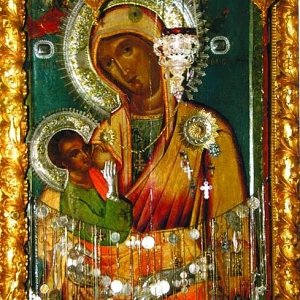
This holy icon of the Virgin Mary Milk-nursing portrays the Blessed Mother of God in a moment of maternal tenderness, holding and nursing the infant Jesus Christ. Due to this particular depiction, the Virgin Galaktotrophousa is associated with the feast of Christmas and is considered unique in the tradition of Mount Athos.
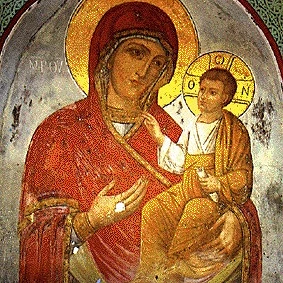
The name of the icon comes from the Greek word “Πυροβοληθείσα” that means "the Shot" and derives from a tragic event that occurred in 1822 A.D. when the Holy Monastery of Vatopaidi was seized by Turkish guards. At that time, a Turkish soldier desecrated the icon of the Theotokos by firing his weapon at it, wounding her right hand. Moments later, this sacrilegious soldier lost his mind and took his own life by hanging himself from an olive tree across from the entrance of the Monastery.
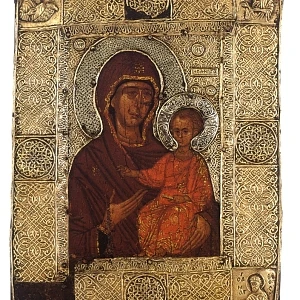
The icon of the Virgin Mary Eleovrytisa is small in size and dates back to approximately the 13th to 14th century, being one of the miraculous icons of Mount Athos. To this day, the venerable icon of the Virgin Mary is kept in the oil cellar (in Greek “Docheio”) of the Holy Great Monastery of Vatopaidi, a space where the monastery’s wine and oil are stored. Due to its placement, the icon has also been given the name "Docheiarissa".
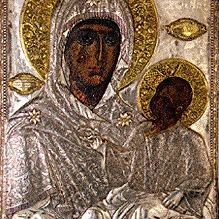
The story of the venerable icon of Our Lady Esfagmeni and the miraculous event associated with it are described in a 17th-century manuscript known as the «Pilgrimage of Vatopedi», specifically in the chapter «Concerning the Holy Icon of the Slaughtered and the Extraordinary Miracle Associated with Her». According to christian tradition, a quirky deacon and ecclesiarch often delayed arriving at the Holy Table due to his service. One day, the monk responsible for the Holy Table, frustrated by the deacon’s constant delays, refused to provide him with food. Driven by anger, the deacon turned toward the icon of the Holy Mother of God and spoke the following words in frustration: «How long will I serve you and toil, and yet you show no care for my sustenance?» In an act of blasphemy, he drew a knife and wounded the face of the Virgin Mary.
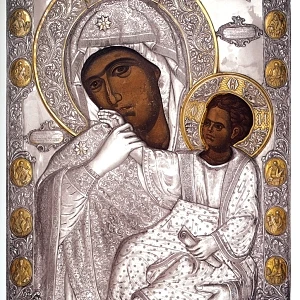
The miraculous icon of Our Lady Paramythia dates back to the 14th century. Initially, it was a wall painting (fresco) at the Katholikon of the Holy Great Monastery of Vatopedi. Following a major miracle, the venerable icon was transferred to the left side of the main gate of the monastery’s Katholikon (the main church), where there is a chapel dedicated to the Virgin Mary Paramythia.
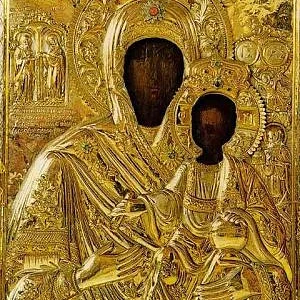
The name ‘Koukouzelisa’ comes from the connection with Saint John Koukouzelis through the vision and the miracle that occurred. For this reason, Saint John was ever-present in the right choir, chanting in honor of the Lord and the Theotokos. The Orthodox Church celebrates our Lady Koukouzelisa on November 21 each year.
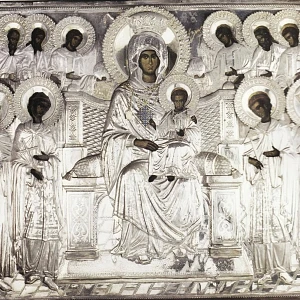
The miraculous icon of Theotokos Economissa is associated with a miracle performed to Saint Athanasios the Athonite. During the period when the Monastery was under construction, supplies and provisions had run out, causing great hardship for the monastic brotherhood. Thus, Saint Athanasios was compelled to travel to Karyes, the capital of Mount Athos, to obtain the necessary provisions for the Monastery. However, along the way, the Mother of God appeared to him, urging him to return to the Monastery, assuring him that the storage rooms were filled with the necessary goods. Indeed, upon his return, Saint Athanasios found the storerooms fully stocked.